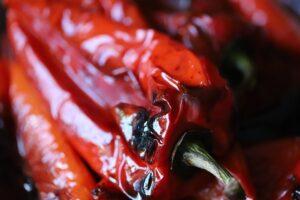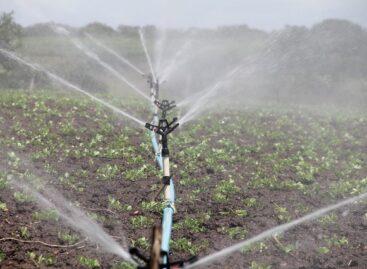If you’re bored with ratatouille, grill the peppers instead!
Baked, boiled, stuffed, ground as a spice… Paprika is a basic and essential ingredient of Hungarian cuisine, from soups to main dishes to pickles. With the arrival of the season, dishes made from peppers come even more to the fore, including the great favorite, ratatouille. Although edible paprika also holds its own in the grilling season, it is also worth tasting it grilled.

(Photo: Pixabay)
At the summer press workshop of the European Fresh Team, chef József Bernáth not only gave practical tips on grilling peppers, but also presented an easy summer recipe. And Luca Kozák, the sports ambassador of the program, followed the path of paprika from the foil tent to the shops.
Although many people do not know, peppers belong to the potato family
It was first mentioned here in the early 1600s under the name Turkish pepper, which was used as a spice to replace pepper. The edible paprika dates back to the 18th century. came to our country in the 19th century through the mediation of Bulgarians fleeing from the Turks. The Bulgarians who settled in Szentes and its surroundings later created a new vegetable gardening system together with the Hungarians, the so-called Bulgarian horticulture, the greatest achievement of which was the breeding and cultivation of domestic paprika. Pepper cultivation is still significant in Hungary, the vegetable cultivated on the largest surface area, especially around Szentes. Luca Kozák, the athlete ambassador of the European Fresh Team, also visited here to learn about the journey of edible peppers from the producer to delivery to the stores at Délkertész, one of the largest domestic pepper producers’ cooperatives, and to present the most popular types and varieties.
The most popular breeds
There are many types of edible peppers, which can have different characteristics: thick or thin, hot or sweet, white, green or colored. Which one we choose depends on what we make of it. The most popular types of paprika here are the white TV pepper, the kápia pepper, and the pointed strong pepper.
TV pepper
TV paprika has nothing to do with TV, its name is an abbreviation of the term “to charge”.
This name refers to one of the possible ways of using white edible pepper – just think of pepper stuffed with minced meat – but it is usually eaten raw with sandwiches, it is added to stews and lechos, but it can also be made into a pickled version filled with cabbage. Everyone knows TV paprika!
Kapia paprika
Kapia is the best choice if you want to grill peppers!
There is a long tradition of making roasted paprika in the Mediterranean and Balkan countries, so it can be used in many other ways: for paprika creams, roasted paprika dishes, and salads. During grilling and baking, the sugar in it caramelizes, which makes it really special in taste.
A ram’s horn
The ram’s horn pepper has been proven for many decades, thanks to the work of Bulgarian gardeners and domestic breeding, it is a popular pepper grown mainly for fresh consumption. It is a type popular primarily among those who do not like the spicy taste, but prefer sharp, strong peppers in their taste. In addition to cold dishes, it is excellent for making pickles, as its crunchy and tasty texture remains even during pickling. Its market importance has decreased in recent years, so today it can be found mostly in home gardens and at some growers.
Sharp strong
If you like a spicy taste, you can eat it with anything. Although it is considered the least hot among the hot peppers grown in the world, the Hungarian hot pepper is internationally recognized, since few nations consume hot peppers raw. Unless you’re eating it for the taste and you can’t really stand the strong taste, it’s worth cutting out the veins and avoiding the seeds, as they contain the highest amount of the compound capsaicin, which gives it a spicy taste! Why do we still eat when it stings? The answer is simple: our brain produces endorphins, i.e. happiness hormones, to protect against the pungent taste, which is why we feel good about it. As a rule of thumb, when working with strong peppers, always wash your hands thoroughly and never touch your eyes.
The science of grilling peppers by József Bernáth
The preparation of delicious dishes begins with the selection, correct storage and professional preparation of the raw materials. When buying peppers, make sure that the skin is shiny and smooth, and that there are no softer spots or visible defects. If the pepper is otherwise intact, but its surface is more wrinkled, it can still be used, just don’t store it for a long time, prepare it as soon as possible. The storage of paprika does not require extra things: keep it in a dry, cool place and put it away without washing, because it deteriorates more easily from moisture. Chef József Bernáth, gastro ambassador of the European Fresh Team, gave good advice at a press workshop for preparing the paprika grill. “The most important thing is to preheat the grill in time, because this way the vegetables will brown perfectly. “Always wash the peppers, drain them and wipe them dry, which is also important because of the browning,” the chef pointed out. The chef made vegetable skewers at the workshop organized in Szentes. For this, the pepper had to be cut up. In this regard, József Bernáth noted that instead of breaking out the chuma, we should remove the seeds by cutting from the top, and it is recommended to remove the veins before cutting. It is also true for grilled vegetables, such as peppers, that you definitely need to coat them with olive oil, and you can also add herbs, for example, thyme goes well with it. Add salt and pepper only at the end. “Grilled peppers are easy to make and delicious! All types are suitable for grilling and gastronomic use. If you don’t want to eat it in “pieces”, I recommend that you feel free to make a cream out of it: for example, you can make a super paprika cream from kápia pepper. added the chef. During grilling, the paprika also gets that real, special flavor that is difficult to replace with anything else, the smoky flavor that only characterizes grilled dishes. Fortunately, if you don’t have a grill, you don’t have to give up this seasonal delicacy either, because it can be prepared in an oven with a grill function and in a pan. Don’t be alarmed even if you roasted a little more pepper and have some left over, because you can still use it in many ways. It can be used as a dip, a topping for sandwiches, or even a pickle, which can be used to preserve the flavors of summer grilling and grilled paprika for winter. So, pepper season is in full swing, let’s taste new flavors and prepare other summer dishes from fresh Hungarian peppers in addition to ratatouille!
NAK
Related news
AM: Government helps farmers with a loan moratorium
🎧 Hallgasd a cikket: Lejátszás Szünet Folytatás Leállítás Nyelv: Auto…
Read more >Ministry of Agriculture: the government is giving priority support to the development of irrigation
🎧 Hallgasd a cikket: Lejátszás Szünet Folytatás Leállítás Nyelv: Auto…
Read more >The government is giving special support to irrigation development
🎧 Hallgasd a cikket: Lejátszás Szünet Folytatás Leállítás Nyelv: Auto…
Read more >Related news
Christmas shock in commerce: for the first time, we can pay with bank cards in fewer places
🎧 Hallgasd a cikket: Lejátszás Szünet Folytatás Leállítás Nyelv: Auto…
Read more >Hungarian Confectionery Manufacturers Association: trends in 2025 and prospects for 2026
🎧 Hallgasd a cikket: Lejátszás Szünet Folytatás Leállítás Nyelv: Auto…
Read more >Most grocery chains will be open until noon on December 24th
🎧 Hallgasd a cikket: Lejátszás Szünet Folytatás Leállítás Nyelv: Auto…
Read more >






